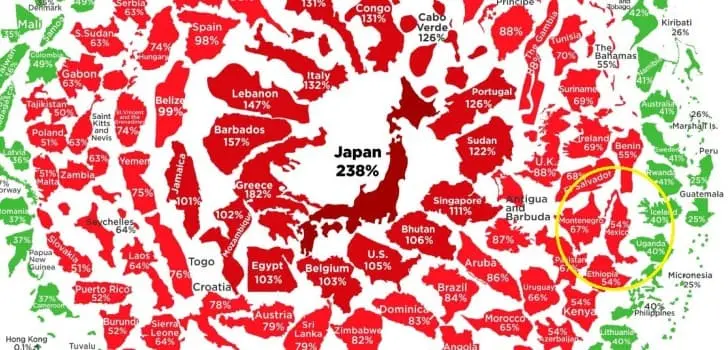External debt, like other economic indicators, does not explain a country’s financial status in a global economy. However, it is a very useful tool for examining the mechanics that nations could present in the medium and long term. On HowMuch, a site specializing in economic issues, they generated this chart to show the countries with the highest and lowest debt worldwide. The main protagonist is Japan, with a debt that amounts to 238% of its Gross Domestic Product.

Then we have the Greeks with a debt of 182% of GDP, a situation that is all too familiar to Europeans. The difference between first and second place is abysmal in macroeconomic terms: 56%. Japan’s debt began to grow in the early 1990s, following the boom of the financial and property bubble, a period known as the “lost decade.” Today, Japan is kept afloat by its efficient tax collection system, but this won’t last forever.
Some estimates suggest that, by the middle of the 21st century, the country could go bankrupt. Economic growth has been stagnant for decades, and the country’s demographic projections are far from encouraging. Despite this, Japan is among the largest economies in the world and its high productivity has meant that the country’s debt burden has not suffocated.
On the other hand, in Greece we can observe what happens when economic problems affect a country. The nightmare of the Greeks did not happen overnight. Added to a long history of poor financial management and falsification of accounts was the economic recession of 2008 and the obstacles that the European Central Bank imposed on the euro. Greece was no longer able to meet payments and ended up with that level of debt. After overcoming the worst part of the crisis, the Greeks managed to keep the country moving forward, still dragging serious problems with it.
A world of debtors.
What’s most interesting about this chart is the variety of countries that top the main list. Among the most indebted are underdeveloped countries with extensive civil conflicts (Congo and Sudan), small islands with poor economic performance (Barbados, Cape Verde) and countries in Europe that are still struggling because of the euro crisis and poor financial management (Italy and Portugal). But we also find one of the fastest growing countries in the world: Singapore.

All of them have an external debt that exceeds 100% of their GDP. And behind them are countries such as Egypt, Belgium, the United States and Jamaica which, in recent decades, have increased their debt for various reasons. In almost all cases, debt partially explains how prosperous (or well-managed) a nation is.
Among the least debtors are nations as problematic in economic performance as Afghanistan (7%) and Botswana (14%). And as rich as Estonia (9%), Saudi Arabia (17%) and Luxembourg (23%).
In short, we observe a debt-driven world in which the negativity or positivity of the percentage depends exclusively on the particular conditions of each country.
